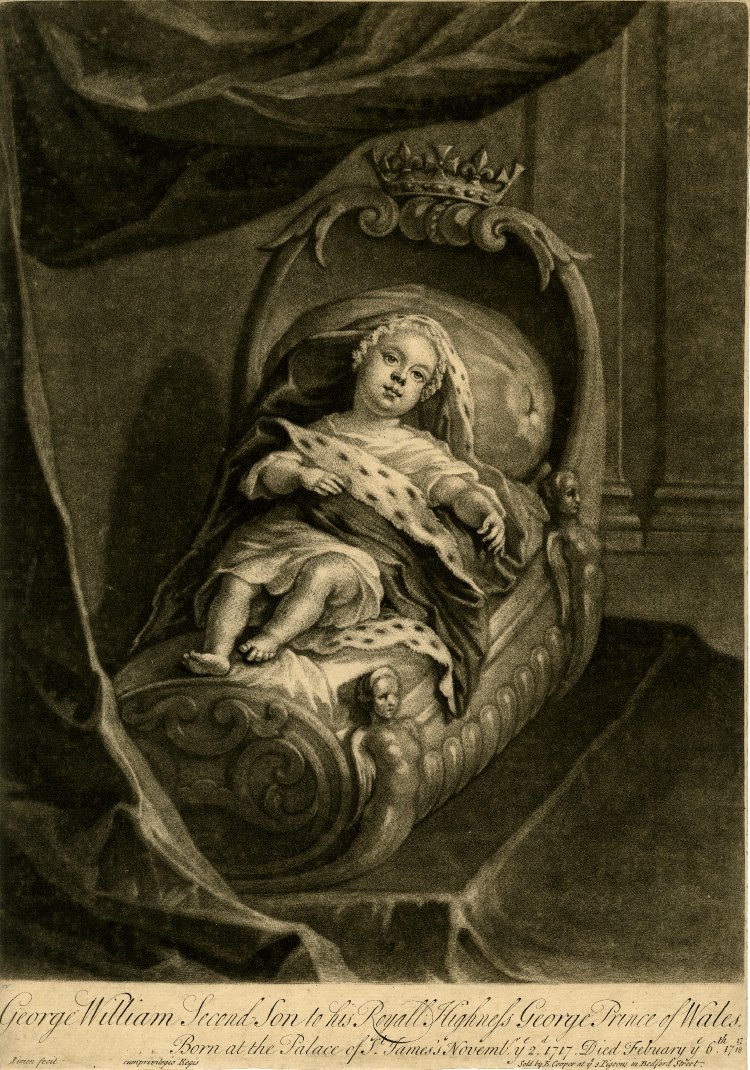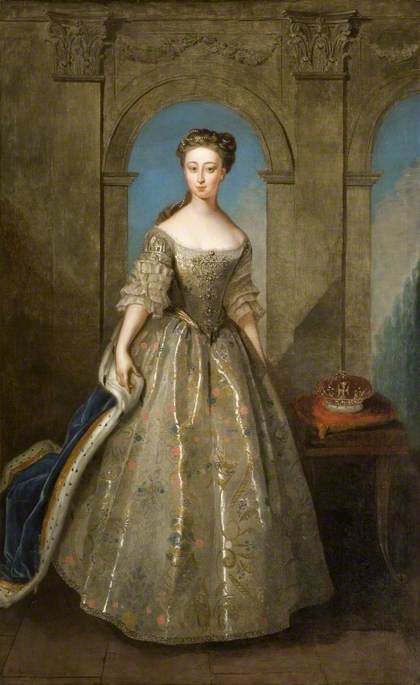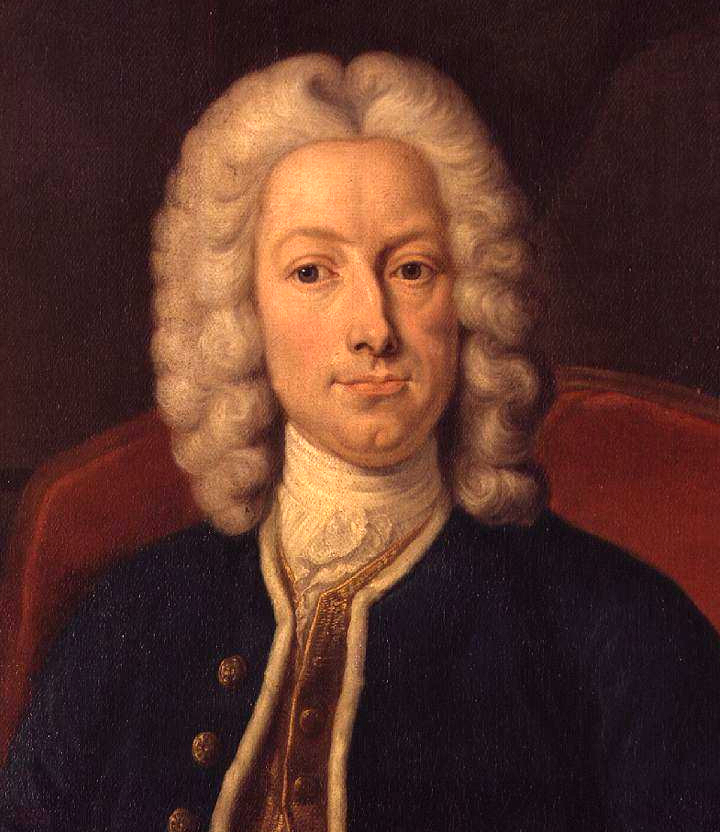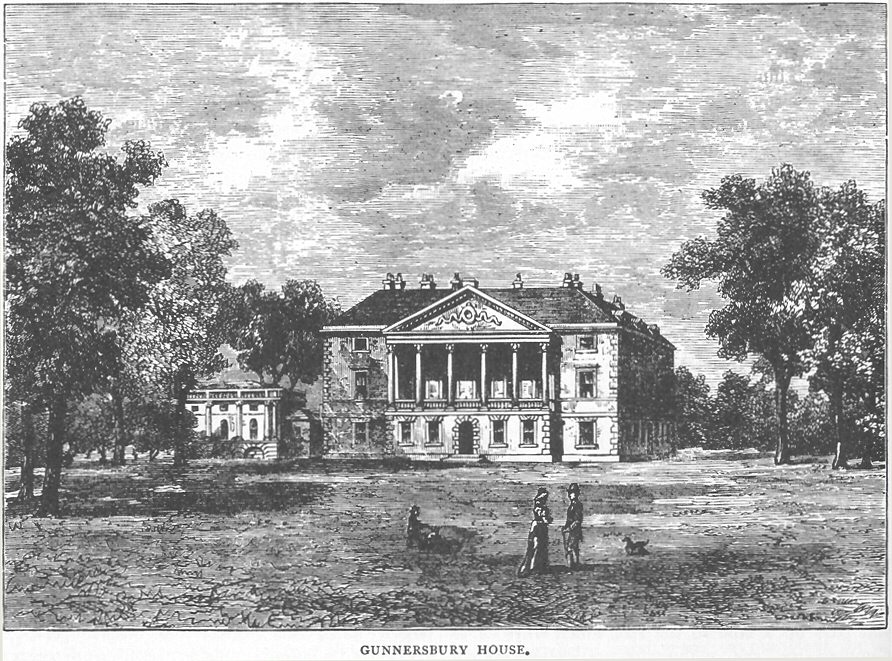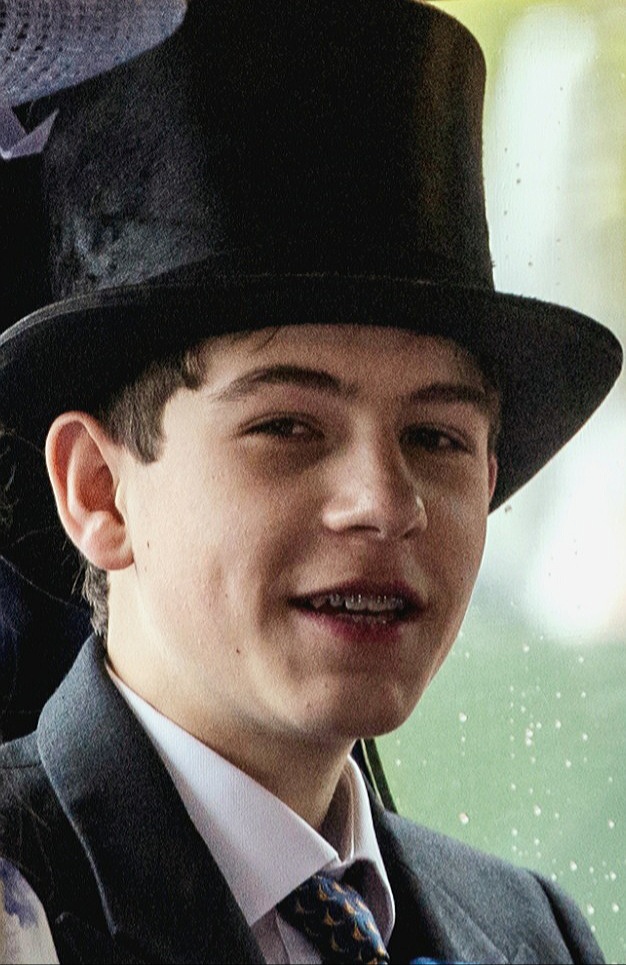by Susan Flantzer
© Unofficial Royalty 2019
Children of the British Royal Family are christened following the Holy Baptism rite of the Church of England of which the monarch is the Supreme Governor. Royal christenings are small, private affairs usually attended by the immediate family, the godparents and their spouses. Only the christening of Princess Eugenie of York, the younger of the two daughters of Prince Andrew, Duke of York and his former wife Sarah, Duchess of York, was held at a regular Sunday service at St. Mary Magdalene Church in Sandringham, Norfolk, England.
Christenings of members of the House of Windsor have been held at intimate settings, mostly palace chapels, including the Private Chapel in Windsor Castle, the Private Chapel at Buckingham Palace, the Music Room at Buckingham Palace, the Chapel Royal in St James’s Palace, and St. Mary Magdalene Church in Sandringham. Only one christening, that of Prince Harry in 1984, was held at a large church, St. George’s Chapel at Windsor Castle, but it was still a private, family affair.
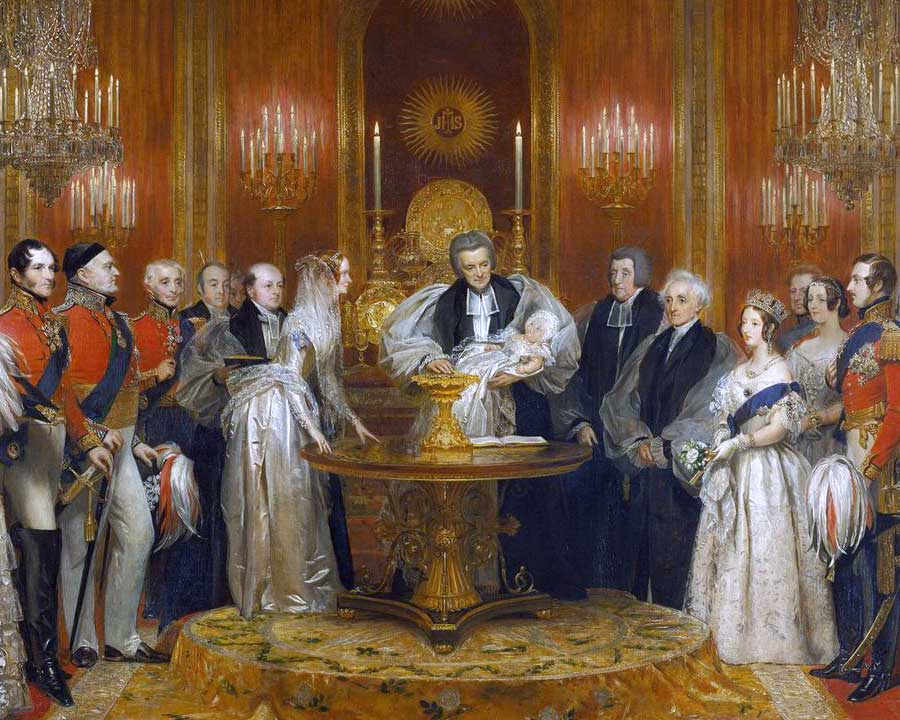
The christening of Victoria, Princess Royal in the Throne Room at Buckingham Palace in 1841; Credit – Wikipedia
Several of the British Royal Family’s christening traditions started with the christening of Queen Victoria’s eldest child. After the birth of her first child Victoria, Princess Royal in 1840, Queen Victoria commissioned a christening gown to be made. The gown of Honiton lace lined with Spitalfields silk was made by Janet Sutherland, the daughter of a Scottish coal miner from Falkirk, who received the title Embroiderer to the Queen for her work. First worn by Victoria, Princess Royal at her christening on February 10, 1841, her parents’ first wedding anniversary, the gown was worn by 62 descendants of Queen Victoria. Lady Louise Windsor, the elder of the two children of Prince Edward, Earl of Wessex and Sophie, Countess of Wessex, was the last to wear the 1841 gown at her christening in 2004.

Exact replica of the original royal christening gown; Credit – www.rct.uk/collection
Due to the gown’s age and delicate condition, Queen Elizabeth II commissioned Angela Kelly, Dressmaker to The Queen, to make a hand-made replica in order to preserve the original. James, Viscount Severn, the younger of the two children of Prince Edward, Earl of Wessex and Sophie, Countess of Wessex, was the first to wear the replica gown at his christening in 2008. Photos of royal babies wearing the original gown and the replica can be seen below.

The Lily Font; Photo Credit – https://www.royalcollection.org.uk
The Lily Font is a silver baptismal font commissioned by Queen Victoria and Prince Albert in 1840 after the birth of their first child, Victoria, Princess Royal. It was first used at the christening of Victoria, Princess Royal in 1841 and has been used for royal christenings ever since except that of Princess Eugenie of York. Prince Albert helped design the font which is made from a silver gilt with the appearance of gold. Three winged cherubs sit on the base of the font above the royal arms of Queen Victoria, Prince Albert, and Victoria, Princess Royal. The cherubs are playing lyres and above them leaves reach up to support the bowl which is edged by water lilies. For the christening of Victoria, Princess Royal, the Lily Font was placed on a table as seen in the portrait above. Sometimes the Lily Font is placed into the larger 1660 Charles II font and its basin or the christening basin made in 1735 and first used at the christening of the future King George III in 1738. The portrait below shows the Lily Font placed in the 1660 Charles II font and basin. The Lily Font is part of the Crown Jewels and is kept at the Jewel House at the Tower of London when not in use.

The Lily Font on top of the Charles II Font and Basin at the christening of Queen Victoria’s eldest son Albert Edward, Prince of Wales in 1842; Credit – Wikipedia
********************
Please note that not all of the photos below are christening photos. The first photo below shows the future King George V wearing the 1841 christening gown.
King George V, born Prince George of Wales

The Princess of Wales holding Prince George; Credit – http://glucksburg.blogspot.com/
- Unofficial Royalty: King George V of the United Kingdom
- Parents: The Prince and Princess of Wales, later King Edward VII and Queen Alexandra
- Born: June 3, 1865 at Marlborough House in London, England
- Christened: July 7, 1865 at the Private Chapel in Windsor Castle in Windsor, England
- Names: George Frederick Ernest Albert
- Godparents:
********************
Queen Mary, born Princess Victoria Mary of Teck
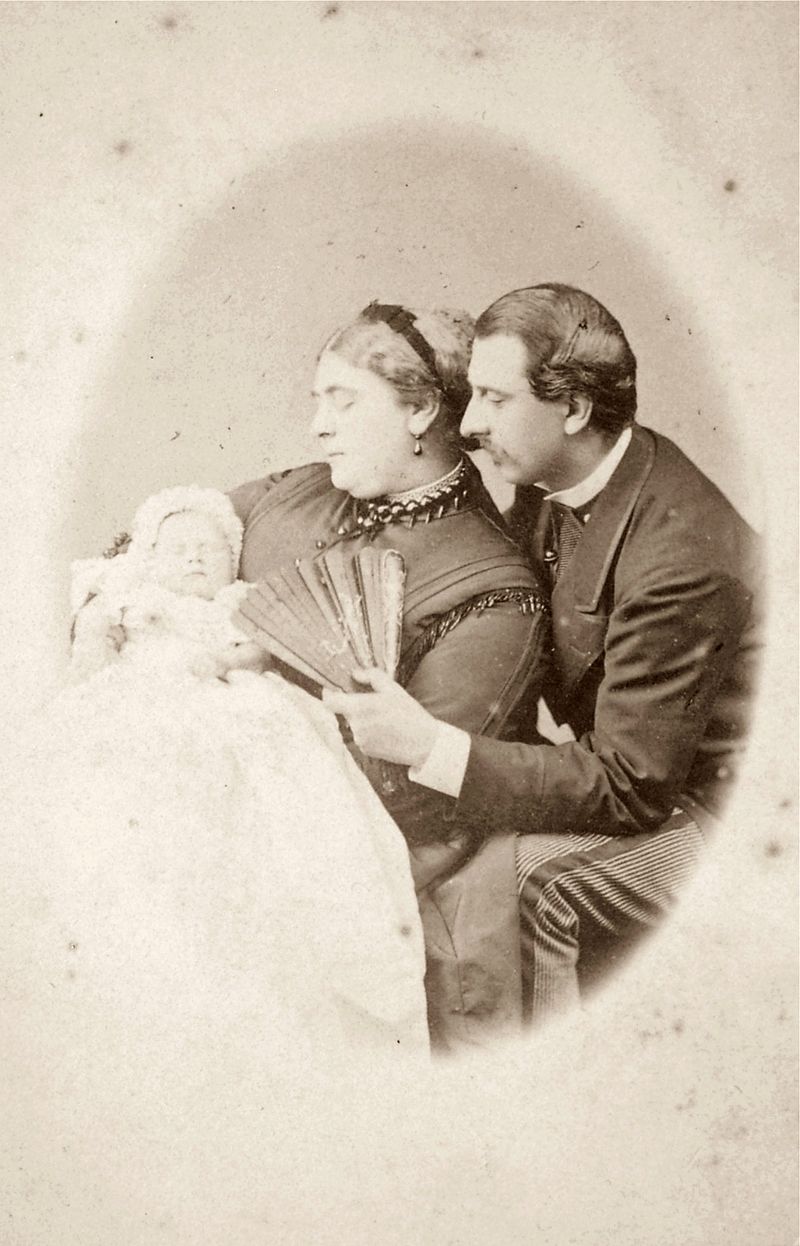
With her parents The Duke and Duchess of Teck; Credit – Wikipedia
********************
The Duke of Windsor, formerly King Edward VIII, born Prince Edward of York
Embed from Getty Images
Four Generations: Queen Victoria holding Prince Edward, The Prince of Wales (later King Edward VII) and The Duke of York (later King George V)
- Unofficial Royalty: King Edward VIII, The Duke of Windsor
- Parents: Prince George, Duke of York and Princess Mary of Teck, later King George V and Queen Mary
- Born: June 23, 1894 at White Lodge in Richmond Park, Surrey, England
- Christened: July 16, 1894 in the Green Drawing Room at White Lodge in Richmond Park, Surrey, England
- Names: Edward Albert Christian George Andrew Patrick David
- Godparents:
- Christian IX, King of Denmark (his maternal great-grandfather)
- Wilhelm II, King of Württemberg (his mother’s distant cousin)
- The Duke of Saxe-Coburg and Gotha and Edinburgh (his father’s paternal uncle Alfred)
- The Prince of Wales (his grandfather, the future King Edward VII)
- Tsesarevich Nicholas Alexandrovich of Russia (the future Nicholas II, Emperor of All Russia, his father’s first cousin)
- The Duke of Teck (his maternal grandfather)
- Prince George, Duke of Cambridge (his mother’s maternal uncle)
- Queen Victoria (his paternal great-grandmother)
- Queen Louise of Denmark (his paternal great-grandmother, born Princess Louise of Hesse-Kassel)
- Queen Olga of Greece (his maternal great-aunt by marriage, born Grand Duchess Olga Konstantinovna of Russia)
- The Princess of Wales (his paternal grandmother, the future Queen Alexandra, born Princess Alexandra of Denmark)
- The Duchess of Teck (his maternal grandmother, born Princess Mary Adelaide of Cambridge)
********************
King George VI, born Prince George of York

The Duchess of York holding Prince Albert; Credit – https://www.royalcollection.org.uk
- Unofficial Royalty: King George VI of the United Kingdom
- Parents: Prince George, Duke of York and Princess Mary of Teck, later King George V and Queen Mary
- Born: December 14, 1895 at York Cottage in Sandringham, Norfolk, England
- Christened: February 17, 1896 at St. Mary Magdalene Church in Sandringham, Norfolk, England
- Names: Albert Frederick Arthur George
- Godparents:
********************
Queen Elizabeth the Queen Mother, born The Honorable Elizabeth Bowes-Lyon
Embed from Getty Images
- Unofficial Royalty: Queen Elizabeth The Queen Mother
- Parents: Claude Bowes-Lyon, Lord Glamis, later the 14th Earl of Strathmore and Kinghorne, and Nina Cecilia Cavendish-Bentinck
- Born: August 4, 1900
- Christened: September 23, 1900 at All Saints Church in St Paul’s Walden Bury, Hertfordshire, England
- Names: Elizabeth Angela Marguerite
- Godparents (incomplete list):
- Lady Maud Bowes-Lyon (her paternal aunt)
- Mrs. Arthur James (her mother’s second cousin, born Venetia Cavendish-Bentinck)
********************
Princess Mary, The Princess Royal, born Princess Mary of York

The Duchess of York with her only daughter Princess Mary
- Unofficial Royalty: Princess Mary, Princess Royal, Countess of Harewood
- Parents: Prince George, Duke of York and Princess Mary of Teck, later King George V and Queen Mary)
- Born: April 25, 1897 at York Cottage in Sandringham, Norfolk, England
- Christened: June 7, 1897 at St. Mary Magdalene Church in Sandringham, Norfolk, England
- Names: Victoria Alexandra Alice Mary
- Godparents:
********************
Prince Henry, The Duke of Gloucester, born Prince Henry of York
Embed from Getty Images
Queen Victoria at Osborne with the children of the Duke and Duchess of York (left to right) Prince Albert (George VI), Princess Mary (Princess Royal, Countess of Harewood), Prince Edward (Edward VIII) and Prince Henry (Duke of Gloucester) on Queen Victoria’s lap
- Unofficial Royalty: Prince Henry, Duke of Gloucester
- Parents: Prince George, Duke of York and Princess Mary of Teck, later King George V and Queen Mary
- Born: March 31, 1900 at York Cottage in Sandringham, Norfolk, England
- Christened: May 17, 1900 in the Private Chapel at Windsor Castle in Windsor, England
- Names: Henry William Frederick Albert
- Godparents:
********************
Prince George, The Duke of Kent, born Prince George of Wales

Prince George with his eldest brother Prince Edward of Wales
- Unofficial Royalty: Prince George, Duke of Kent
- Parents: Prince George, Prince of Wales and Princess Mary of Teck, later King George V and Queen Mary
- Born: December 20, 1902 at York Cottage in Sandringham, Norfolk, England
- Christened: January 26, 1903 in the Private Chapel at Windsor Castle in Windsor, England
- Names: George Edward Alexander Edmund
- Godparents:
********************
Prince John of the United Kingdom, born Prince John of Wales

Queen Mary; Prince George, Duke of Kent; Princess Mary, Countess of Harewood; Prince John; Prince Henry, Duke of Gloucester by William Edwin Sorrell, published by Rotary Photographic Co Ltd bromide postcard print, 1905 NPG x29776 © National Portrait Gallery, London
- Unofficial Royalty: Prince John of the United Kingdom
- Parents: Prince George, Prince of Wales and Princess Mary of Teck, later King George V and Queen Mary)
- Born: July 12, 1905 at York Cottage in Sandringham, Norfolk, England
- Christened: August 3, 1905 at St. Mary Magdalene Church in Sandringham, Norfolk, England
- Names: John Charles Francis
- Godparents:
********************
Alastair Windsor, 2nd Duke of Connaught, born Prince Alastair of Connaught

Photo Credit – www.royalcollection.org.uk
- Wikipedia: Alastair Windsor, 2nd Duke of Connaught
- Parents: Prince Arthur of Connaught and Princess Alexandra, 2nd Duchess of Fife
- Born: August 9, 1914 at 54 Mount Street in Mayfair, London, England
- Christened: August 25, 1914 at 54 Mount Street in Mayfair, London, England
- Names: Alastair Arthur
- Godparents:
- King George V (his father’s first cousin and his mother’s uncle)
- Alfonso XIII, King of Spain (husband of his father’s first cousin and his mother’s first cousin once removed)
- Prince Arthur, Duke of Connaught (his paternal grandfather and his mother’s great-uncle)
- Queen Alexandra (his father’s aunt by marriage and his maternal great-grandmother)
- Princess Louise, Duchess of Argyll (Queen Victoria’s daughter, his father’s aunt and his mother’s great-aunt)
- Princess Mary (his father’s first cousin once removed and his mother’s first cousin)
********************
Queen Elizabeth II, born Princess Elizabeth of York
Embed from Getty Images
Back Row (left to right): The Duke of Connaught, King George V, The Duke of York, The Earl of Strathmore; Front Row (left to right): Lady Elphinstone, Queen Mary, The Duchess of York holding Princess Elizabeth, The Countess of Strathmore, Princess Mary, Viscountess Lascelles
- Unofficial Royalty: Queen Elizabeth II of the United Kingdom
- Parents: Prince Albert, Duke of York and Lady Elizabeth Bowes-Lyon, later King George VI and Queen Elizabeth
- Born: April 21, 1926 at 17 Bruton Street in Mayfair, London, England
- Christened: May 29, 1926 in the Private Chapel at Buckingham Palace in London, England
- Names: Elizabeth Alexandra Mary
- Godparents:
********************
Prince Philip, The Duke of Edinburgh, born Prince Philippos of Greece and Denmark
Embed from Getty Images
- Unofficial Royalty: Prince Philip, Duke of Edinburgh
- Parents: Prince Andrew of Greece and Princess Alice of Battenberg
- Born: June 10, 1921 at the Villa Mon Repos on the Isle of Corfu, Greece
- Christened: [no date] at St. George’s Church in the Old Fortress in Corfu, Greece according to the rites of the Greek Orthodox Church
- Name: Philippos
- Godparents:
- Queen Olga of Greece (his paternal grandmother, born Grand Duchess Olga Konstantinovna of Russia)
- The Corfu City Council (represented by Alexander S. Kokotos, Mayor of Corfu and Stylianos I. Maniarizis, Chairman of the City Council)
********************
Princess Margaret, Countess of Snowdon, born Princess Margaret of York
Embed from Getty Images
Princess Margaret with her mother The Duchess of York
- Unofficial Royalty: Princess Margaret, Countess of Snowdon
- Parents: Prince Albert, Duke of York and Lady Elizabeth Bowes-Lyon, later King George VI and Queen Elizabeth)
- Born: August 21, 1930 at Glamis Castle in Glamis, Angus, Scotland
- Christened: October 30, 1930 in the Private Chapel at Buckingham Palace in London, England
- Names: Margaret Rose
- Godparents:
********************
Prince Edward, The Duke of Kent, born Prince Edward of Kent

Credit – Prince George, Duke of Kent; Prince Edward, Duke of Kent; Princess Marina, Duchess of Kent by Unknown photographer, bromide print, 1936, NPG x182255 © National Portrait Gallery, London
- Unofficial Royalty: Prince Edward, Duke of Kent
- Parents: Prince George, Duke of Kent and Princess Marina of Greece
- Born: October 9, 1935 at 3 Belgrave Square in London, England
- Christened: November 20. 1935 in the Private Chapel at Buckingham Palace in London, England
- Names: Edward George Nicholas Paul Patrick
- Godparents:
********************
Princess Alexandra, The Honorable Lady Ogilvy, born Princess Alexandra of Kent
- Unofficial Royalty: Princess Alexandra, The Honorable Lady Ogilvy
- Parents: Prince George, Duke of Kent and Princess Marina of Greece
- Born: December 25, 1936 at 3 Belgrave Square in London, England
- Christened: February 9, 1937 in the Private Chapel at Buckingham Palace in London, England
- Names: Alexandra Helen Elizabeth Olga Christabel
- Godparents:
********************
Prince William of Gloucester
Embed from Getty Images
Back Row (left to right): The Duke of Gloucester, King George VI, Lord William Montagu Douglas Scott; Front Row (left to right): Princess Helena Victoria, The Duchess of Gloucester, Queen Mary holding her grandson, Lady Margaret Hawkins
- Unofficial Royalty: Prince William of Gloucester
- Parents: Prince Henry, Duke of Gloucester and Lady Alice Montagu-Douglas Scott
- Born: December 18, 1941 at Hadley Common in Hertfordshire, England
- Christened: February 22, 1942 in the Private Chapel at Windsor Castle in Windsor, England
- Names: William Henry Andrew Frederick
- Godparents:
********************
Prince Michael of Kent
Embed from Getty Images
Prince Michael with his family at his christening; three weeks later his father was killed in a plane crash
- Unofficial Royalty: Prince Michael of Kent
- Parents: Prince George, Duke of Kent and Princess Marina of Greece
- Born: July 4, 1942 at Coppins in Iver, Buckinghamshire, England
- Christened: August 4, 1942 in the Private Chapel at Windsor Castle in Windsor, England
- Names: Michael George Charles Franklin
- Godparents:
********************
Prince Richard, The Duke of Gloucester, born Prince Richard of Gloucester

Prince Richard with his brother Prince William and his mother The Duchess of Gloucester; Credit – cms.countrylife.co.uk
- Unofficial Royalty: Prince Richard, Duke of Gloucester
- Parents: Prince Henry, Duke of Gloucester and Lady Alice Montagu-Douglas-Scott
- Born: August 26, 1944 at Hadley Common in Hertfordshire, England
- Christened: October 20, 1944 in the Private Chapel at Windsor Castle in Windsor, England
- Names: Richard Alexander Walter George
- Godparents:
********************
King Charles III of the United Kingdom, born Prince Charles of Edinburgh
Christening of the future King Charles III with his parents and godparents: Seated left to right: Dowager Marchioness of Milford Haven (born Victoria of Hesse and by Rhine), the then Princess Elizabeth holding the infant Charles and Queen Mary. Standing left to right: Patricia Knatchbull, Baroness Brabourne, Prince Philip, Duke of Edinburgh (representing godparent Prince George of Greece), King George VI, David Bowes-Lyon, Alexander Cambridge, 1st Earl of Athlone (representing godparent King Haakon of Norway), and Princess Margaret
- Unofficial Royalty: King Charles III of the United Kingdom
- Parents: Prince Philip, Duke of Edinburgh and Princess Elizabeth, later Queen Elizabeth II
- Born: November 14, 1948 at Buckingham Palace in London, England
- Christened: December 15, 1948 in the Music Room at Buckingham Palace in London, England
- Names: Charles Philip Arthur George
- Godparents:
********************
Diana, Princess of Wales, born The Honorable Lady Diana Spencer
- Unofficial Royalty: Diana, Princess of Wales
- Parents: John Spencer, Viscount Althorp, later the 8th Earl Spencer, and The Honourable Frances Burke Roche
- Born: July 1, 1961 at Park House in Sandringham, Norfolk, England
- Christened: August 30, 1961 at St. Mary Magdalene Church in Sandringham, England
- Names: Diana Frances
- Godparents:
- John Floyd (Chairman of Christie’s, her father’s friend)
- Alexander Gilmour (her father’s cousin)
- Lady Mary Colman (niece of Queen Elizabeth the Queen Mother)
- Mrs. Michael Pratt (friend and neighbour of Diana’s parents)
- Mrs. William Fox (friend and neighbour of Diana’s parents)
********************
Camilla, Queen Consort of the United Kingdom, born Camilla Shand

Camilla on left with her siblings, Mark in the middle and Annabel on the right; Photo Credit – www.dailymail.co.uk
- Unofficial Royalty: Camilla, Queen Consort of the United Kingdom
- Parents: Major Bruce Shand and The Honourable Rosalind Cubitt
- Born: July 17, 1947 at King’s College Hospital, Denmark Hill, London
- Christened: November 1, 1947 at Firle Church in Lewes, Sussex, England
- Names: Camilla Rosemary
- Godparents:
- The Honourable Harry Cubitt (her maternal uncle, later the 4th Baron Ashcombe)
- Major Neil Speke
- Mrs. Lombard Hobson
- Mrs. Heathcoat Amory
- Miss Vivien Mosley
********************
Princess Anne, The Princess Royal, born Princess Anne of Edinburgh
Embed from Getty Images
Back Row (left to right): 1st Earl Mountbatten of Burma, Princess Margarita of Greece and Denmark and The Honorable Reverand Andrew Elphinstone. Front Row (left to right): Princess Alice, Countess of Athlone, Princess Elizabeth holding Princess Anne and Queen Elizabeth
- Unofficial Royalty: Princess Anne, The Princess Royal
- Parents: Prince Philip, Duke of Edinburgh and Princess Elizabeth, later Queen Elizabeth II
- Born: August 15, 1950 at Clarence House in London, England
- Christened: October 21, 1950 in the Music Room at Buckingham Palace in London England
- Names: Anne Elizabeth Alice Louise
- Godparents:
********************
Prince Andrew, The Duke of York

Andrew on his christening day with his parents and his elder brother Charles and elder sister Anne; Photo Credit – daysofmajesty.blogspot.com
- Unofficial Royalty: Prince Andrew, Duke of York
- Parents: Prince Philip, Duke of Edinburgh and Queen Elizabeth II
- Born: February 19, 1960 at Buckingham Palace in London, England
- Christened: April 8, 1960 in the Music Room at Buckingham Palace in London England
- Names: Andrew Albert Christian Edward
- Godparents:
********************
Prince Edward, The Duke of Edinburgh
- Unofficial Royalty: Prince Edward, Duke of Edinburgh
- Parents: Prince Philip, Duke of Edinburgh and Queen Elizabeth II
- Born: March 10, 1964 at Buckingham Palace in London, England
- Christened: May 2, 1964 in the Private Chapel at Windsor Castle in Windsor, England
- Names: Edward Antony Richard Louis
- Godparents:
********************
Prince William, The Prince of Wales, born Prince William of Wales
Embed from Getty Images
The Prince and Princess of Wales with Prince William and his godparents (seated) ex-King Constantine of Greece, (standing, left to right) Princess Alexandra, Lord Romsey, Lady Hussey, Sir Laurens Van Der Post and the Duchess of Westminster
- Unofficial Royalty: Prince William, The Prince of Wales
- Parents: Prince Charles, Prince of Wales and Lady Diana Spencer
- Born: June 21, 1982 at St. Mary’s Hospital in Paddington, London, England
- Christened: August 4, 1982 in the Music Room at Buckingham Palace in London, England
- Names: William Arthur Philip Louis
- Godparents:
********************
Catherine, The Princess of Wales, born Catherine Middleton
- Unofficial Royalty: Catherine, The Princess of Wales
- Parents: Michael Middleton and Carole Goldsmith
- Born: January 9, 1982 at Royal Berkshire Hospital in Reading, Berkshire, England
- Christened: June 20, 1982 at St. Andrew’s Church in Bradfield, Berkshire, England
- Names: Catherine Elizabeth
- Godparents:
********************
Prince Harry, The Duke of Sussex, born Prince Harry of Wales

Prince Harry’s Christening; Photo Credit – www.abc.net.au
- Unofficial Royalty: Prince Harry, Duke of Sussex
- Parents: Prince Charles, Prince of Wales and Lady Diana Spencer
- Born: September 15, 1984 at St. Mary’s Hospital in Paddington, London, England
- Christened: December 21, 1984 at St George’s Chapel, Windsor Castle in Windsor, England
- Names: Henry Charles Albert David
- Godparents:
********************
Princess Beatrice of York

Princess Beatrice’s christening; Photo Credit – entertainment.xin.msn.com
- Unofficial Royalty: Princess Beatrice of York
- Parents: Prince Andrew, Duke of York and Sarah Ferguson
- Born: August 8, 1988 at Portland Hospital in London, England
- Christened: December 20, 1988 at the Chapel Royal in St James’s Palace in London, England
- Names: Beatrice Elizabeth Mary
- Godparents:
- David Armstrong-Jones, 2nd Earl of Snowdon (her father’s first cousin)
- Peter Palumbo, Baron Palumbo (her maternal grandfather’s friend)
- The Duchess of Roxburghe (the former Lady Jane Grosvenor, later Lady Jane Dawnay)
- The Honourable Mrs. John Greenall (her mother’s friend, the former Gabrielle James)
- Mrs. Henry Cotterell (her mother’s friend, the former Carolyn Beckwith-Smith)
********************
Princess Eugenie of York

photo: Days of Majesty
- Unofficial Royalty: Princess Eugenie of York
- Parents: Prince Andrew, Duke of York and Sarah Ferguson
- Born: March 23, 1990 at Portland Hospital in London, England
- Christened: December 23, 1990 at St. Mary Magdalene Church in Sandringham, Norfolk, England
- Names: Eugenie Victoria Helena
- Godparents:
- James Ogilvy (her father’s second cousin)
- Captain Alastair Ross (her father’s former commander on HMS Edinburgh)
- Mrs. Ronald Ferguson (her mother’s stepmother)
- Mrs. Patrick (Julia) Dodd-Noble (her parents’ friend)
- Miss Louise Blacker (her mother’s friend)
********************
Lady Louise Mountbatten-Windsor

Front row (left to right) The Duke of Edinburgh, The Queen, The Earl of Wessex, The Countess of Wessex holding Lady Louise, Mr and Mrs Christopher Rhys-Jones, back row (left to right) Lord Ivar Mountbatten, Lady Alexandra Etherington, Lady Sarah Chatto, Mrs Urs Schwarzenbach and Mr Rupert Elliott; Photo by Lichfield/Getty Images
- Unofficial Royalty: Lady Louise Mountbatten-Windsor
- Parents: Prince Edward, Earl of Wessex and Sophie Rhys-Jones
- Born: November 8, 2003 at Frimley Park Hospital in Frimley, Surrey, England
- Christened: April 24, 2004 in the Private Chapel at Windsor Castle in Windsor, England
- Names: Louise Alice Elizabeth Mary
- Godparents:
- Lady Alexandra Etherington (her father’s third cousin, daughter of James Carnegie, 3rd Duke of Fife)
- Lady Sarah Chatto (her father’s first cousin)
- Lord Ivar Mountbatten (her father’s second cousin, son of David Mountbatten, 3rd Marquess of Milford-Haven)
- Rupert Elliott (her father’s friend from Cambridge University)
- Francesca Schwarzenbach (her parents’ friend)
********************
James Mountbatten-Windsor, Earl of Wessex

James, Viscount Severn with his parents; Credit – Daily Mail/Camera Press
- Unofficial Royalty: James Mountbatten-Windsor, Viscount Severn
- Parents: Prince Edward, Earl of Wessex and Sophie Rhys-Jones
- Born: December 17, 2007 at Frimley Park Hospital in Frimley, Surrey, England
- Christened: April 19, 2008 in the Private Chapel at Windsor Castle in Windsor, England
- Names: James Alexander Philip Theo
- Godparents:
- Denise Poulton (a friend of his mother and trustee of the Wessex Youth Trust)
- Jeanye Erwin (his mother’s former flat-mate)
- Alastair Bruce of Crionaich
- Duncan Bullivant (a school friend of his father)
- Thomas Hill
********************
Prince George of Wales, born Prince George of Cambridge

Four generations: Prince George with his father, grandfather, and great-grandmother; photo: Jason Bell/Camera Press
- Unofficial Royalty: Prince George of Wales
- Parents: Prince William, The Prince of Wales and Catherine Middleton
- Born: July 22, 2013 at the Lindo Wing of St Mary’s Hospital in Paddington, London, England
- Christened: October 23, 2013 in the Chapel Royal at St. James’ Palace in London, England
- Names: George Alexander Louis
- Godparents:
********************
Princess Charlotte of Wales, born Princess Charlotte of Cambridge
- Unofficial Royalty: Princess Charlotte of Wales
- Parents: Prince William, The Prince of Wales and Catherine Middleton
- Born: May 2, 2015 at the Lindo Wing of St Mary’s Hospital in Paddington, London, England
- Christened: July 5, 2015 at St. Mary Magdalene Church in Sandringham, Norfolk, England
- Names: Charlotte Elizabeth Diana
- Godparents:
- The Honorable Laura Fellowes (maternal first cousin of her father)
- Adam Middleton (paternal first cousin of his mother)
- Thomas van Straubenzee (a close friend)
- James Meade (a close friend)
- Sophie Carter (a close friend)
********************
Prince Louis of Wales, born Prince Louis of Cambridge
- Unofficial Royalty: Prince Louis of Wales
- Parents: Prince William, The Prince of Wales and Catherine Middleton
- Born: April 23, 2018 at the Lindo Wing of St Mary’s Hospital in Paddington, London, England
- Christened: July 9, 2018, at The Chapel Royal, St. James’s Palace in London, England
- Names: Louis Arthur Charles (Louis is pronounced Lou-ee)
- Godparents
- Mr. Nicholas van Cutsem (a friend of his father)
- Mr. Guy Pelly (a friend of his father)
- Mr. Harry Aubrey-Fletcher (an Eton College friend of his father)
- Lady Laura Meade (friend of his father formerly Laura Marsham, daughter of Julian Marsham, 8th Earl of Romney; wife of James Meade who is a godfather of Princess Charlotte)
- Mrs. Robert (Hannah) Carter (a school friend of his mother)
- Miss Lucy Middleton (paternal first cousin of his mother)
********************
Prince Archie of Sussex
- Unofficial Royalty: Prince Archie of Sussex
- Parents: Prince Harry, Duke of Sussex and Meghan Markle
- Born: May 6, 2019, at the Portland Hospital for Women and Children in London, England
- Christened: July 6, 2019 at the Private Chapel in Windsor Castle in Windsor, England
- Names: Archie Harrison
- Godparents: The identity of the godparents was not made public.
********************
Princess Lilibet of Sussex
- Unofficial Royalty: Princess Lilibet of Sussex
- Parents: Prince Harry, Duke of Sussex and Meghan Markle
- Born: June 4, 2021, at Santa Barbara Cottage Hospital in Santa Barbara, California,
- Christened: March 3, 2023 at the family home in Montecito, California
- Names: Lilibet Diana
- Godparents: Tyler Perry (friend of her parents)
This article is the intellectual property of Unofficial Royalty and is NOT TO BE COPIED, EDITED, OR POSTED IN ANY FORM ON ANOTHER WEBSITE under any circumstances. It is permissible to use a link that directs to Unofficial Royalty.
